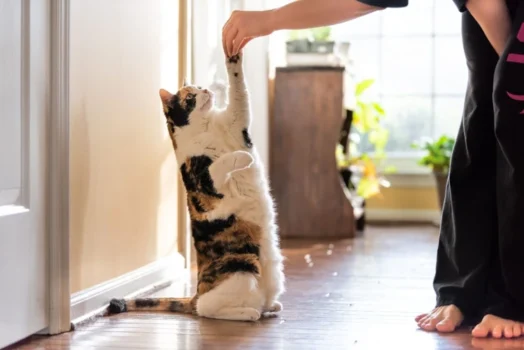For feline lovers, having a beautiful California Spangled cat can be a fulfilling experience. These cats are popular for their distinctive spotted markings and their active, intelligent personalities. However, despite their lovable demeanor, unwanted behaviors can disrupt their owners and impede a harmonious home. If you’re experiencing behavioral issues with your California Spangled cat, don’t despair. This comprehensive guide is here to help you understand the breed’s personality, identify common behavioral problems, and provide training techniques to address them. With patience, consistency, and positive reinforcement, you can create a healthy and happy environment for both you and your furry friend.
Understanding California Spangled Cats
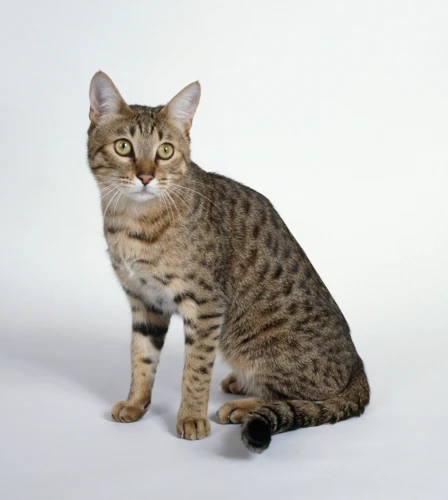
As a cat breed, the California Spangled Cat is known for its distinctive appearance, playful personality, and inquisitive nature. If you’re considering adopting one of these unique felines, it’s helpful to familiarize yourself with their physical and behavioral characteristics. By understanding their breed traits, you can create an ideal environment and training plan that will help them thrive. To learn more about the California Spangled Cat and how to train them effectively, check out our guide to positive reinforcement training techniques.
Physical Characteristics
California Spangled cats are known for their unique and striking physical appearance. These cats were bred to resemble wild cats like leopards, ocelots, and jaguars. They have a muscular and athletic body, and a short, glossy coat that comes in various colors including brown, silver, black, and gold.
Here are some physical characteristics that make California Spangled cats stand out:
| Characteristic | Description |
|---|---|
| Head | Small to medium-sized with a straight nose and almond-shaped eyes. |
| Ears | Medium-sized and set apart, with rounded tips. |
| Body | Muscular and athletic with a broad chest, long legs, and a straight tail. |
| Fur | Short, dense, and glossy with a distinctive spotted or marbled pattern. |
| Size | Medium to large-sized with males weighing between 10 and 15 pounds, and females weighing between 8 and 12 pounds. |
| Coat Colors | California Spangled cats can come in different colors, including silver, bronze, black, and gold. |
Their unique appearance combined with their friendly and affectionate personality make California Spangled cats a sought-after pet. To keep them healthy and happy, it’s important to address their unwanted behaviors using proper training techniques. You can use positive reinforcement training, such as clicker training and target training, as well as providing adequate exercise and environmental enrichment. If you want to learn more about specific training techniques, visit our article on clicker training for California Spangled cats.
Behavioral Characteristics
California Spangled cats are known for their inquisitive, playful, and energetic personalities. They are intelligent animals that need both mental and physical stimulation to prevent behavioral issues. Additionally, interactive games and puzzles can also help keep them occupied and entertained, which is essential for their overall well-being.
One of the most unique behavioral characteristics of these felines is their love for water. These cats are often fascinated with water and may even join their owners in the shower or bath. Owners can use this trait to their advantage when it comes to training and enrichment, such as setting up a shallow pool or a running fountain.
California Spangled cats are also generally social and enjoy the company of their owners. They often seek out affection and are prone to suffer from separation anxiety if left alone for too long. It’s important to provide them with frequent attention and playtime to meet their social needs.
Another behavioral trait that is common to California Spangled cats is their strong prey drive. They love to hunt and pounce on objects, which is why interactive toys that mimic movement and hide treats can help keep them engaged. Training techniques that simulate hunting can also be an effective way to keep the cat engaged.
These felines are independent and do not tolerate being restrained or confined for extended periods. This means that harsh training methods or punishment should be avoided as they can cause stress and anxiety in the cat. Instead, positive reinforcement training should be used to encourage and reward good behavior.
By understanding these unique behavioral characteristics of California Spangled cats, owners can develop training strategies that can help their feline overcome unwanted behaviors and maintain good behavior. With proper training, this breed can become a well-behaved, well-adjusted companion for its owner to enjoy. For more training tips, visit /teaching-tricks-california-spangled-cat/.
Common Unwanted Behaviors in California Spangled Cats
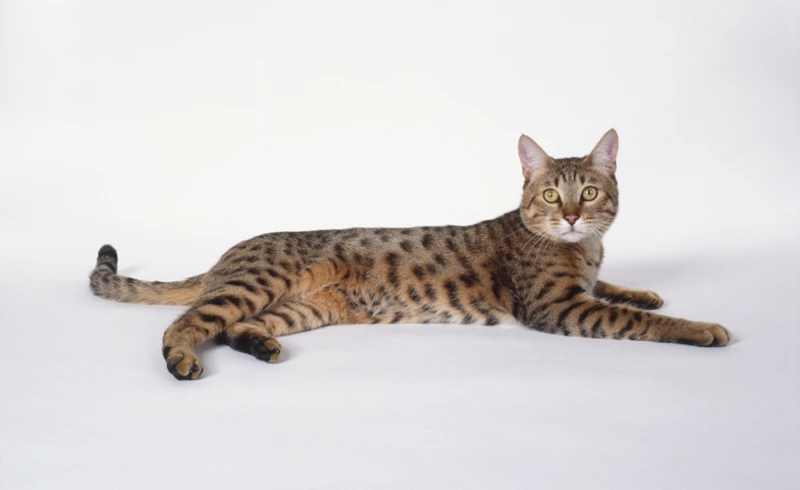
As much as we adore our California Spangled cats, there are times when their behaviors get out of control and become unmanageable. It can be frustrating to deal with common unwanted behaviors such as aggression, destructive behavior, excessive vocalization, and scratching furniture. However, it’s important to remember that these behaviors can be addressed and corrected with the right techniques and strategies. Let’s take a look at some effective ways to train your California Spangled cat and tackle those unwanted behaviors head-on.
Aggression
Aggression in California Spangled cats can be a serious issue if not addressed promptly. It’s important to note that aggression in cats can have various causes, such as fear, territoriality, or stress.
Identifying Types of Aggression:
To address aggression in your California Spangled cat, the first step is to identify the type of aggression your cat is displaying. Below is a table that outlines the different types of aggression and their characteristics:
| Type of Aggression | Characteristics |
|---|---|
| Play Aggression | Chasing, pouncing, biting, and kicking during playtime. |
| Predatory Aggression | Stalking, focusing on prey, crouching, and pouncing suddenly on moving targets. |
| Territorial Aggression | Aggression shown towards other cats or animals who intrude on the cat’s space or territory. |
| Fear Aggression | Defensive aggressiveness shown when the cat feels scared or threatened. |
| Pain-Induced Aggression | Aggressive behavior caused by physical pain or discomfort. |
Addressing Aggression:
Once you have identified the type of aggression your California Spangled cat is displaying, there are several techniques you can use to address it.
Play Aggression: Provide your cat with plenty of toys to play with and engage in interactive playtime sessions with your cat. This helps redirect their playful aggression towards appropriate outlets.
Predatory Aggression: Prevent your cat from practicing predatory behavior by limiting their exposure to potential prey. Provide plenty of toys that replicate the movement of prey, such as small plush toys.
Territorial Aggression: Introduce cats slowly and gradually, keeping them separated at first. Provide each cat with their own resources, such as food, water, litter boxes, and sleeping areas.
Fear Aggression: Provide your cat with safe spaces within the house where they can retreat when feeling scared. Avoid physically punishing your cat, as it can exacerbate their fear and anxiety.
Pain-Induced Aggression: Take your cat to a veterinarian to rule out any underlying medical issues. If there is pain or discomfort, provide appropriate medication and handling to avoid causing further pain.
Remember, aggression in cats should be taken seriously and addressed immediately to ensure the safety and well-being of both your cat and yourself.
Internal Link: For more information on litter box training your California Spangled kitten, visit our article on Litter Training a California Spangled Kitten.
Destructive Behavior
California Spangled cats have been known to exhibit destructive behavior like scratching furniture, chewing on cords, digging in plants, and even urinating or defecating outside of the litter box. This can be frustrating for owners and lead to damage in the household.
1. Providing Appropriate Scratching Surfaces: As scratching is a natural behavior for cats, it is important to provide appropriate scratching surfaces to redirect your cat’s destructive behavior. These can include scratching posts, scratching mats, or even a cardboard box. Make sure to place these surfaces where your cat spends the most time, and encourage them to use them by placing treats or toys on them.
2. Deter with Scents: Cats also dislike certain smells, and can be deterred from scratching or chewing on furniture if it has a scent they don’t like. Spraying scents like citrus or lavender near the area you want to protect can help keep your cat away.
3. Cover Furniture: Covering furniture with blankets or slipcovers can also help protect it from your cat’s destructive behavior. If your cat has a preferred spot to scratch or chew on, consider placing double-sided tape or aluminum foil on the area to physically deter them.
4. Provide Mental and Physical Stimulation: Destructive behavior in cats can sometimes be a result of boredom or lack of stimulation. Providing toys, puzzles, and interactive playtime can help keep your cat mentally and physically engaged, reducing the likelihood of destructive behavior.
5. Proper Training: Training your cat to redirect their behavior towards appropriate scratching surfaces can take time and patience, but it is possible. Utilize positive reinforcement techniques like clicker training or target training to gradually teach your cat where it is acceptable to scratch.
It’s important to remember that punishment or physical discipline is not effective in stopping destructive behavior and can damage your relationship with your cat. Instead, focus on positive reinforcement and providing appropriate outlets for your cat’s natural behavior.
For more information on training California Spangled cats, such as leash training, check out our article on walking your California Spangled cat on a leash.
Excessive Vocalization
California Spangled cats are known for their talkative nature and love for attention, but excessive vocalization can be a sign of an underlying issue. This can include attention-seeking behavior, stress, anxiety, or even medical problems. As a cat owner, it’s important to identify the cause of your cat’s excessive vocalization and address it accordingly.
Identifying the Cause of Excessive Vocalization
The first step in addressing excessive vocalization in your California Spangled cat is to identify the cause. This can be done by observing your cat’s behavior and looking for any triggers. If your cat is meowing excessively for attention, try to give them more playtime and affection throughout the day. If your cat is stressed or anxious, consider environmental enrichment strategies to help provide a sense of calm. If you suspect a medical problem, consult with your veterinarian to rule out any underlying health issues.
Environmental Enrichment Strategies
Environmental enrichment is an effective strategy to reduce excessive vocalization in cats. This can include providing plenty of toys, scratching posts, and perches for your cat to play with and on. Additionally, providing comforting items such as blankets or a comfortable bed can help your cat feel more secure and calm.
Behavior Modification through Environmental Control
In some cases, environmental factors can trigger excessive vocalization in cats. For example, if your cat sees other animals outside and starts meowing excessively, closing the blinds or curtains can help block the view and reduce the behavior. Similarly, reducing exposure to loud music or other loud noises can help reduce stress and anxiety in your cat.
Providing Adequate Exercise
Another effective strategy for reducing excessive vocalization in cats is to provide adequate exercise. This can include playing with your cat for several minutes each day, or providing plenty of toys and play areas for your cat to explore on their own. Regular exercise can help your cat release pent-up energy and reduce anxiety, which in turn can help reduce excessive vocalization.
Conclusion
Excessive vocalization in California Spangled cats can be a challenging behavior to address, but with patience and proper management techniques, it can be successfully addressed. Remember to identify the cause, provide environmental enrichment, modify behavior through environmental control, provide adequate exercise, and maintain consistency with positive reinforcement. Observing these guidelines will help ensure that your California Spangled cat stays happy, healthy, and well-behaved.
| Identifying the Cause of Excessive Vocalization | The first step in addressing excessive vocalization in your cat is to identify the cause. This can be done by observing your cat’s behavior and looking for any triggers. |
|---|---|
| Environmental Enrichment Strategies | Environmental enrichment is an effective strategy to reduce excessive vocalization in cats. This can include providing plenty of toys, scratching posts, and perches for your cat to play with and on. |
| Behavior Modification through Environmental Control | In some cases, environmental factors can trigger excessive vocalization in cats. Reducing exposure to loud music or other loud noises can help reduce stress and anxiety in your cat. |
| Providing Adequate Exercise | Providing regular exercise can help your cat release pent-up energy and reduce anxiety, which in turn can help reduce excessive vocalization. |
Scratching Furniture
For many cat owners, a common problem they face is their California Spangled Cats scratching furniture. This behavior can be incredibly frustrating and costly, as it can damage expensive items in the home. However, it’s important to understand that scratching is a natural behavior for cats, and with the right training and management strategies, you can help redirect their behavior to appropriate areas.
Understanding Why Cats Scratch Furniture
There are a few reasons why cats scratch furniture:
- Marking their territory: Scratching helps cats mark their territories by leaving behind both visual and scent marks.
- Stretching their muscles: Scratching can also help cats stretch their muscles after a nap or rest.
- Keeping their nails healthy: Scratching allows cats to remove the outer layers of their nails, which helps keep them healthy.
Training Techniques to Address Scratching Behavior
To address the unwanted behavior of scratching furniture, you can use the following positive reinforcement training techniques:
- Provide appropriate scratching posts: Provide your California Spangled Cats with appropriate scratching posts or pads made with materials that are similar to what they enjoy scratching, such as sisal, cardboard, or carpet.
- Positive reinforcement: Encourage your cat to use the appropriate scratching area by positively reinforcing their behavior with treats or praise when they use it successfully.
- Discourage inappropriate scratching: If you catch your cat scratching furniture, make a loud noise or clap your hands to startle them, then gently redirect their behavior to the appropriate area. Do not punish your cat, as this can lead to fear and anxiety.
Additional Management Strategies
In addition to training techniques, you can also use these management strategies to address scratching behavior:
- Limit access to furniture: Limit your cat’s access to areas where they have scratched furniture in the past. You can use baby gates or close doors to keep them from accessing those areas.
- Protect furniture: Cover the furniture with materials that are unappealing for your cat to scratch, such as aluminum foil, double-sided tape, or citrus spray. These materials can be removed once your cat has learned to use appropriate scratching posts consistently.
By using these positive reinforcement training techniques and management strategies, you can help redirect your California Spangled Cats’ scratching behavior to appropriate areas and maintain your furniture in good shape. Remember to be patient and consistent in your training efforts, and your cat will soon learn the appropriate behavior.
Positive Reinforcement Training Techniques
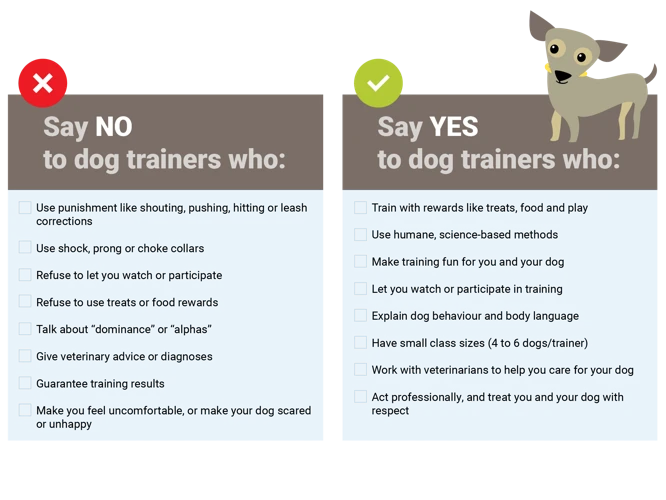
Training your California Spangled cat with positive reinforcement techniques can be a highly effective way of addressing unwanted behaviors. By using reinforcement methods based on rewarding good behavior instead of punishing bad behavior, you create a positive and proactive environment for your feline friend. It may take some time and patience, but with the proper techniques, you can train your cat to behave the way you want it to. In this section, we will discuss several positive reinforcement training techniques that you can use to modify and improve your California Spangled cat’s behavior. So, let’s dive into the highlights of positive reinforcement training and discover how it can benefit your cat and your bond with it.
Clicker Training
Clicker training is a positive reinforcement training technique that is widely used for training cats. In clicker training, a small handheld clicker is used to create a sound that signals to the cat that they have performed the desired behavior. This sound is then followed by a treat or reward.
The benefits of clicker training include:
| Benefit | Description |
| Clear communication | The clicker sound provides a clear and concise way to communicate with the cat and reinforce desired behaviors. |
| Improved timing | The clicker allows for precise timing of the reinforcement, which is essential for effective training. |
| Increased motivation | Clicker training can be a fun and engaging way to train cats, which can increase their motivation to learn and perform new behaviors. |
| Reduced stress | Positive reinforcement training techniques like clicker training can help reduce stress and anxiety in cats, making training more effective and enjoyable. |
Steps to implement clicker training:
1. Introduce the clicker: Start by introducing the clicker sound to the cat and pairing it with a treat or reward. Click the clicker and immediately give the cat a treat. Repeat this several times.
2. Associate the clicker with a behavior: Once the cat is comfortable with the sound of the clicker, start using it to reinforce desired behaviors. Click the clicker immediately when the cat performs the desired behavior and follow it up with a treat or reward.
3. Build on the behavior: Once the cat is consistently performing the desired behavior with the clicker, start to build on it by adding cues or shaping the behavior in new ways.
4. Fade the clicker: Over time, the cat should begin to associate the reward with the behavior rather than the sound of the clicker. At this point, the clicker can be faded out and replaced with a verbal cue.
Clicker training can be a fun and effective way to train California Spangled Cats and address unwanted behaviors. It is important to remember to always use positive reinforcement and to avoid punishing or scolding the cat for unwanted behaviors.
Target Training
One effective positive reinforcement technique for training California Spangled cats is called target training. This training technique can help redirect your cat’s focus to an appropriate behavior, and away from any unwanted behavior.
What is target training?
Target training involves using a target, such as a stick or a finger, to guide your cat’s behavior. The target can be used to encourage your cat to perform a desired behavior, such as sitting, jumping, or even walking on a leash. The target is used as a marker for the desired behavior, and can be combined with treats or other incentives to reinforce the behavior and encourage repetition.
How can target training be used to address unwanted behaviors?
Target training can be used to redirect your cat’s attention away from an unwanted behavior and towards a more desirable behavior. For example, if your cat is scratching furniture, you can use a target to guide them towards a scratching post instead. If your cat is vocalizing excessively, you can use a target to encourage them to focus on a toy or other object, distracting them from the unwanted behavior.
How to practice target training
To practice target training with your California Spangled cat, follow these steps:
| Step | Description |
|---|---|
| 1 | Choose a target, such as a stick or a finger |
| 2 | Introduce the target to your cat, allowing them to sniff and investigate it |
| 3 | Use the target to guide your cat towards a desired behavior, such as sitting or using a scratching post |
| 4 | Click a clicker or use a verbal marker, such as “yes,” when your cat performs the desired behavior |
| 5 | Reward your cat with a treat or other positive reinforcement |
| 6 | Repeat the process, gradually increasing the difficulty of the desired behavior |
With consistent practice and positive reinforcement, target training can be an effective tool for addressing unwanted behaviors in your California Spangled cat. Remember to be patient and reward your cat for progress and effort, rather than only perfect behavior.
Proper Use of Treats
When it comes to positive reinforcement training for California Spangled Cats, treats can be an effective motivator when used properly. It is important to remember that treats should not be given too often, as they can lead to weight gain and unhealthy habits. Here are some tips for the proper use of treats in training:
- Choose appropriate treats: Use small, bite-sized treats that your cat loves, but that are also healthy. Pieces of cooked chicken or tuna, or specially made cat treats, are good options.
- Use treats as a reward: Treats should be given as a reward for good behavior. For example, if your cat scratches their scratching post instead of your furniture, give them a treat.
- Don’t use treats to lure: Treats should not be used to lure your cat into performing a behavior. Instead, wait for your cat to perform the behavior on their own, then reward them with a treat.
- Be consistent: Treats should be given consistently for the same behavior. This will help your cat understand what they are being rewarded for.
- Be patient: It may take some time for your cat to understand what behavior is being rewarded. Be patient and consistent, and your cat will eventually catch on.
By following these proper use of treats guidelines, you can effectively utilize positive reinforcement in your training efforts with your California Spangled Cat. Remember to keep treats to a minimum and use them as a reward for good behavior, and your cat will be more likely to continue exhibiting positive behaviors.
Corrective Actions
When addressing unwanted behavior in California Spangled cats, corrective actions can come into play when other methods have failed. The following are some corrective actions that can be used in conjunction with positive reinforcement training techniques:
- Timeouts: Using a timeout can be an effective way to stop an unwanted behavior. When the cat engages in a negative or harmful behavior, place them in a designated timeout area, such as a bathroom or laundry room, for a set amount of time, usually no longer than ten minutes.
- Redirecting: If a cat is engaging in unwanted behavior, such as scratching furniture, redirect their attention to a more appropriate object such as a scratching post. This can be achieved by luring them towards the post with treats or toys and rewarding them for using it.
- Distracting: If a cat is about to engage in unwanted behavior, such as climbing on a table, distract them by throwing a toy or treat in a different direction. This will divert their attention away from the unwanted behavior and towards the new stimulus.
- Gentle Correction: If a cat is engaging in unwanted behavior, such as biting or scratching, use a gentle but firm voice to say ‘no’ and stop the behavior. However, it’s important to remember not to use physical punishment, as this can lead to fear and anxiety in the cat.
It’s important to note that while corrective actions can be effective in stopping unwanted behaviors, positive reinforcement techniques should still be used in conjunction for long-term success. By consistently using positive reinforcement and corrective actions when needed, California Spangled cats can learn to engage in more desirable behaviors and become well-behaved household pets.
Additional Management Strategies
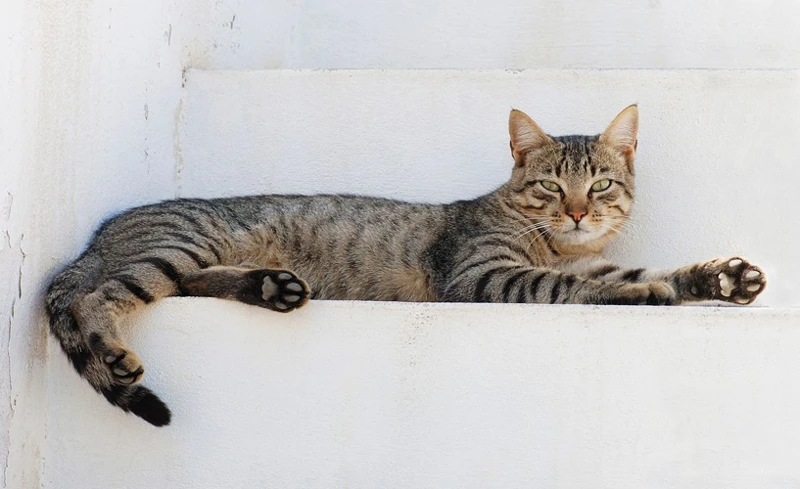
As a California Spangled Cat owner, it’s important to understand that managing unwanted behaviors extends beyond just training techniques. There are other management strategies that can be applied to create a happy, healthy, and well-behaved feline companion. In this section, we’ll explore additional strategies you can use to reinforce good behavior and eliminate unwanted behaviors in your California Spangled Cat. These strategies incorporate environmental enrichment, behavior modification, and providing enough exercise to keep your furry friend happy and active.
Environmental Enrichment
Environmental enrichment can enhance the quality of life for your California Spangled cat by fulfilling their natural behaviors. To keep them mentally stimulated, you can provide them with a variety of toys, climbing structures, and scratching posts. Here are some ideas for creating an enriched environment for your feline friend:
- Vertical Space: Provide your cat with tall climbing trees or shelving units, which can help them meet their natural instinct for climbing and perching.
- Hideouts: Place cozy beds and hiding spaces in different areas of your home to offer your California Spangled cat a sense of security and privacy.
- Interactive toys: Provide puzzle feeders and toys that dispense treats, making mealtime more exciting and challenging for your cat.
- Nature-inspired toys: Bring elements of the wild indoors with toy mice, birds, and other interactive toys that mimic the movements and sounds of prey animals.
- Changing Toys: Introduce new toys and rotate them daily to keep your cat interested and engaged.
When it comes to environmental enrichment, it’s important to pay attention to your cat’s preferences and interests. Try different types of toys and scratching posts to see which ones your cat enjoys the most. Additionally, placing objects near windows or setting up a bird feeder outside can provide your cat with visual or auditory stimulation. By providing environmental enrichment, you can help ensure your California Spangled cat is happy and fulfilled in their home environment.
Behavior Modification through Environmental Control
Behavior modification through environmental control is an effective way to address unwanted behaviors in California Spangled Cats. By modifying the environment, you can help eliminate triggers that cause unwanted behaviors.
Examples of Environmental Modifications:
| Unwanted Behavior | Environmental Modification |
|---|---|
| Scratching Furniture | Provide scratching posts and redirect cat to use them |
| Excessive Vocalization | Limit exposure to stimulating sights and sounds such as other pets or loud noises |
| Destructive Behavior | Provide toys and interactive play to keep the cat mentally stimulated |
| Aggression | Separation from triggers such as other pets or visitors |
It’s important to identify what triggers unwanted behaviors in your California Spangled Cat and make the necessary changes. Providing a comfortable space with adequate toys, scratchers, and places to climb can help reduce unwanted behaviors. Consistency is key when making environmental modifications. It may take several weeks or even months for the cat to learn and adjust to the new space.
Using pheromone sprays or diffusers can be helpful in calming and reducing anxiety in cats. These products mimic the natural pheromones that cats produce and can help create a sense of calm in the environment.
Behavior modification through environmental control is an effective strategy to help eliminate unwanted behaviors in your California Spangled Cat. By modifying the cat’s space and limiting exposure to triggers, you can help create a comfortable and calm environment for your furry friend.
Providing Adequate Exercise
One effective way to address unwanted behaviors in California Spangled Cats is by providing them with adequate exercise. Regular exercise can reduce stress and alleviate anxiety, making your cat less likely to engage in destructive or aggressive behavior. Here are some tips to help you provide your cat with enough physical activity:
- Playtime: Make sure to spend at least 20 minutes each day engaging your cat in interactive playtime. Use toys that they can chase, pounce on, and bat around to keep them engaged and active.
- Laser Pointer: If your cat enjoys chasing lights, a laser pointer can be a fun way to provide exercise. However, make sure to avoid shining it directly in their eyes, as this can cause vision damage.
- Scratching Posts: Investing in a high-quality scratching post can provide your cat with an effective way to stretch and exercise their muscles while filing down their nails. This can also help prevent destructive scratching behavior on furniture.
- Outdoor Enclosures: If your cat enjoys spending time outdoors, consider investing in an outdoor enclosure that allows them to explore and get physical activity in a safe and secure environment.
Remember, each cat is unique and may have different exercise preferences. Observe your cat’s behavior and adjust your exercise routine accordingly to ensure that they are getting the most out of their playtime. By providing your California Spangled cat with adequate exercise, you can help reduce unwanted behaviors and create a happier and healthier pet.
Dealing with Specific Behaviors
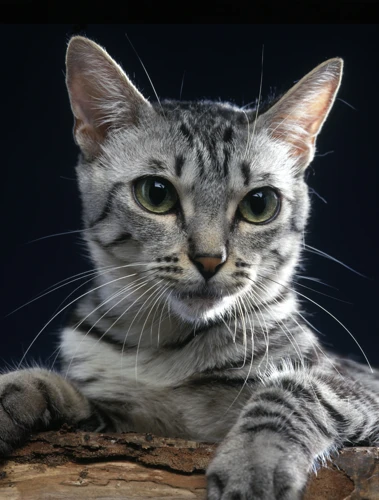
As much as we may try to prevent them, unwanted behaviors can still occur in our beloved California Spangled Cats. It’s important to address these issues as soon as possible to prevent them from becoming habits. In this section, we’ll delve into specific behaviors such as aggression, destructive scratching, and litter box issues. We’ll discuss the underlying causes of these behaviors and provide practical solutions to help you and your feline friend live a happier, harmonious life together. So let’s dive in and explore these behaviors in more depth.
Aggression Towards Humans
Aggression towards humans is a serious issue when it comes to California Spangled Cats. This can manifest in various ways such as scratching, biting, and even hissing. It is important to understand the root cause of this behavior and address it appropriately, as well as taking measures to prevent it from happening in the future.
One possible reason for aggression towards humans in California Spangled Cats could be fear or anxiety. This may happen if the cat has had negative experiences with humans in the past or if they are not used to being handled. It is important to pay attention to a cat’s body language and behavior to determine if they are feeling uneasy or threatened.
Another possible reason for aggression towards humans could be territorial behavior. Cats are known for their territorial nature and may become aggressive when they feel like their space is being invaded. This could happen if someone enters their personal space or if they feel threatened by another person or animal in the household.
To address this behavior, it is important to practice positive reinforcement techniques. This involves rewarding the cat for good behavior such as following commands or coming to you when called. Clicker training is a popular method for positive reinforcement training and involves using a clicker and treats to reinforce desired behavior.
Additionally, it is important to make sure the cat has a designated and safe space that they can retreat to when feeling threatened or uncomfortable. This could be a specific room or a cat tree. Providing a scratching post or pad can also help redirect the cat’s aggression towards furniture or other items.
Table:
| Possible Reasons for Aggression Towards Humans | How to Address the Behavior |
|---|---|
| Fear or Anxiety | -Pay attention to body language and behavior-Practice positive reinforcement techniques-Provide a designated safe space |
| Territorial Behavior | -Make sure the cat has a designated and safe space-Provide a scratching post or pad-Do not invade the cat’s personal space |
It is important to remember that addressing aggression towards humans in California Spangled Cats requires patience and consistency. Punishment or aggression towards the cat will only reinforce negative behavior. By implementing positive reinforcement techniques and providing a safe and comfortable environment, the cat can learn to trust and feel comfortable around humans.
Aggression Towards Other Pets
Aggression towards other pets is a common problem with California Spangled Cats. These cats are inherently territorial, and they can become aggressive towards other pets, especially other cats. This aggression can lead to fights, injuries, and other problems that can affect the health and safety of all pets involved.
Causes of Aggression Towards Other Pets
There are several reasons why a California Spangled Cat may become aggressive towards other pets. One of the most common reasons is territoriality. Spangled cats are very territorial animals, and they may become aggressive towards other cats that they perceive as a threat to their territory. Another common reason for aggression towards other pets is fear or anxiety. If a cat is afraid of another pet, they may lash out aggressively as a defense mechanism.
Training and Management Techniques
If you have a California Spangled Cat that is displaying aggression towards other pets, there are several things you can do. First, it is important to separate the pets and provide them with separate living areas if possible. This will help to reduce the likelihood of conflicts and aggression.
One effective training technique for reducing aggression towards other pets is desensitization. This involves gradually introducing the California Spangled Cat to the other pet, in a controlled and supervised environment. The cat is rewarded for calm and non-aggressive behavior, and over time, they may become less aggressive towards the other pet.
Another effective technique is positive reinforcement training. This involves rewarding the California Spangled Cat for good behavior and ignoring bad behavior. This can help to reinforce positive behaviors and reduce the likelihood of aggression towards other pets.
Environmental Management
In addition to training and management techniques, there are some environmental modifications that can be made to reduce aggression towards other pets. For example, providing each pet with their own food and water dish, litter box, and sleeping area can help to reduce conflicts and territorial behavior.
It is also important to provide plenty of resources for play and exercise, such as toys, scratching posts, and climbing structures. This can help to reduce stress and anxiety, which can contribute to aggressive behavior towards other pets.
Aggression towards other pets is a common problem with California Spangled Cats, but there are several effective training and management techniques that can be used to reduce this behavior. By providing separate living areas, introducing pets gradually, and reinforcing positive behavior, you can help to create a safe and harmonious environment for all of your pets.
Destructive Scratching
Destructive scratching is a common issue for California Spangled Cats and can cause damage to furniture, carpets, and other household items. This behavior is a natural instinct for cats, as it helps them mark their territory and keep their claws sharp. However, it can be frustrating for owners when their furniture is being destroyed. Here are some techniques you can use to address this unwanted behavior:
| Identify the Cause: | It’s important to determine why your California Spangled Cat is scratching excessively. If they are not using their scratching post, it may be due to the location or type of the post. Alternatively, if they are scratching furniture, it could be due to stress or boredom. |
| Provide Plenty of Scratching Options: | Make sure your cat has multiple scratching posts around the house, including vertical and horizontal options. You can also try offering different materials, such as carpet, cardboard, or sisal. |
| Redirect Their Scratching: | If your cat continues to scratch furniture or other items, redirect their attention to their scratching post. Use toys or catnip to entice them to the post and reward them when they use it. |
| Deter Their Behavior: | Place double-sided tape or aluminum foil on the furniture to make it less appealing to scratch. You can also use a spray deterrent, such as citrus or vinegar. |
Remember, punishment is not an effective method for stopping destructive scratching in California Spangled Cats. Instead, focus on positive reinforcement for using the scratching post and redirecting their attention away from furniture. With patience and effort, you can train your cat to use appropriate scratching surfaces and preserve your household items.
Excessive Vocalization
Excessive vocalization is when your California Spangled cat meows or makes other noises excessively. While it is normal for cats to make noises, excessive vocalization can become a problem for some owners. Excessive meowing can be caused by various reasons, including hunger, stress, anxiety, or simply wanting attention. Here are some techniques to help reduce excessive vocalization behavior in your cat:
| Techniques | Benefits |
|---|---|
| Providing Adequate Attention: | Some cats meow excessively because they crave attention. Giving them the attention they need can help reduce their excessive vocalization. Try to spend more time playing or interacting with them. |
| Identifying Triggers: | Try to figure out what triggers your cat’s excessive meowing. This can help you come up with a plan for managing their behavior. For example, if your cat meows excessively before feeding time, try feeding them more regularly. |
| Ignoring: | If your cat is meowing just for attention, ignoring their behavior may help to reduce it. However, make sure that you’re still meeting their needs, such as providing food and water. |
| Offering Distractions: | Give your cat something to do when they start meowing excessively. Offer them toys, play with them or provide them with their favorite treats as a distraction. |
| Medical Issues: | If your cat’s meowing is excessive or out of character, it may be due to an underlying medical issue. If you have concerns, we recommend consulting with a veterinarian to rule out any medical conditions. |
Remember, always use positive reinforcement and avoid punishing your cat for excessive vocalization as it can worsen the behavior. Instead, try implementing these techniques consistently and reward them for good behavior. With time, patience, and consistency, you can help your cat overcome their excessive vocalization and have a more peaceful household.
Litter Box Issues
Litter box issues are one of the most common unwanted behaviors in California Spangled cats. If not addressed promptly and properly, it can lead to major problems in the household. Some of the most common litter box issues are listed below along with the possible causes and solutions.
| Possible Issue | Cause | Solution |
|---|---|---|
| Not using the litter box | Medical issues, stress, dislike of litter type, location or cleanliness | Consult a veterinarian to rule out any medical conditions. Provide a litter box in a quiet, private location with a litter type and texture that the cat prefers. Clean the litter box frequently and thoroughly. |
| Urinating outside the litter box | Medical issues, territorial marking, stress, dislike of litter type or location | Consult a veterinarian to rule out any medical conditions. Provide multiple litter boxes in different locations. Clean the litter boxes frequently and thoroughly. Use pheromone sprays or diffusers to reduce stress. |
| Defecating outside the litter box | Medical issues, dislike of litter type, dissatisfaction with the litter box | Consult a veterinarian to rule out any medical conditions. Provide a litter box with a larger and more open design. Choose a litter type and texture that the cat prefers. Clean the litter box frequently and thoroughly. |
| Kicking litter out of the box | High litter level, dislike of litter type, dissatisfaction with litter box design | Reduce the litter level in the box to half inch. Ensure the litter box has a lid or is deep enough. Choose a litter type that the cat prefers. |
It is important to note that punishment is not an effective solution for litter box issues. It can increase the stress and anxiety levels of the cat, leading to even more unwanted behaviors. It is recommended to address the underlying causes and provide effective solutions with positive reinforcement techniques.
Maintaining Good Behavior
As a California spangled cat owner, maintaining good behavior in your feline friend is essential for a happy and harmonious household. Fortunately, with consistent training techniques and proper environmental management, positive behavior can become a natural part of your cat’s daily routine. In this section, we will explore key strategies and tips for maintaining the good behavior of your California spangled cat. So let’s dive into these helpful practices to keep your cat happy and well-behaved.
Consistency
Consistency is key when it comes to training a California Spangled Cat or any pet. This means maintaining a steady routine and sticking to it as closely as possible. This includes feeding times, play times, and training sessions. Here are some tips for staying consistent with your training:
| Tips for Consistency in Training |
|---|
| Set a schedule and stick to it. Plan out specific times for training, feeding, and playtime, and try your best to adhere to them every day. |
| Be patient. Some cats may take longer than others to learn new behaviors, but consistency will increase the chances of success. |
| Use the same commands and signals every time. This will help your cat recognize and respond to the desired behaviors. |
| Involve other family members or caregivers in the training process. This will ensure that everyone is consistent in their approach and reinforces the same behaviors. |
| Stay positive. Even if your cat is not responding as quickly as you would like, keep a positive attitude and remain diligent in your approach. |
Remember, cats respond best to consistency and positive reinforcement. By setting up a consistent routine and reinforcing desired behaviors, you can help your California Spangled Cat learn and maintain good behavior.
Positive Reinforcement
Positive reinforcement is one of the most effective ways to train your California Spangled cat and encourage good behavior. This training technique involves rewarding your cat when they exhibit desirable behavior, which increases the likelihood of them repeating that behavior in the future.
The benefits of positive reinforcement training
Using positive reinforcement training has several benefits, including:
| Benefit | Description |
|---|---|
| Develops trust and strengthens the bond between you and your cat | Positive reinforcement training creates a positive association between your cat and you, building a stronger bond and trust over time. |
| Encourages good behavior | Rather than punishing undesirable behavior, positive reinforcement training rewards your cat for good behavior, encouraging them to repeat it in the future. |
| Helps manage stress and anxiety | Positive reinforcement training can help reduce stress and anxiety in cats, providing them with a sense of security and control over their environment. |
Examples of positive reinforcement techniques
There are several positive reinforcement techniques that you can use to train your California Spangled cat. These include:
| Technique | Description |
|---|---|
| Using treats | Treats are a classic form of positive reinforcement training. When your cat exhibits good behavior, such as using the scratching post instead of your couch, you can reward them with a small treat. |
| Using verbal praise | Cats respond well to verbal praise, and a simple “good job!” after demonstrating good behavior can be enough to encourage them to repeat that behavior. |
| Using toys | Playing with toys is a great way to encourage good behavior and reduce undesirable behavior. If your cat scratches the designated scratching post instead of your furniture, you can reward them with playtime using their favorite toy. |
Important considerations when using positive reinforcement training
While positive reinforcement training is effective, it’s important to keep a few things in mind:
| Consideration | Description |
|---|---|
| Be consistent | Consistency is key when using positive reinforcement training. Reward your cat every time they exhibit desirable behavior to reinforce this behavior. |
| Use treats in moderation | While treats can be effective, it’s important not to overuse them. Too many treats can lead to weight gain and other health problems in your cat. |
| Be patient | Positive reinforcement training may take time, so be patient as your cat learns new behaviors. With time and consistency, your cat will quickly learn what’s expected of them. |
Positive reinforcement training is a highly effective technique for encouraging good behavior in your California Spangled cat. Use treats, praise, and toys as rewards, and be consistent, patient, and moderate when using this method. By doing so, you’ll build a stronger bond with your cat and enjoy a happier, more well-behaved feline companion.
Regular Exercise and Attention
Cats, including the California Spangled, require regular exercise and attention to maintain good behavior. Regular exercise helps them to release pent-up energy, which can prevent destructive behavior. It provides them with the necessary stimulation they need to stay healthy and happy. Attention is important because cats are social animals that require human interaction. Lack of attention can lead to behavioral problems, such as excessive vocalization and destructive behavior.
Some ways you can provide your cat with regular exercise include:
- Interactive toys: Using toys that require your cat to move and play will help them to release energy and provide mental stimulation.
- Scratching posts: Providing your cat with a scratching post will not only help to prevent destructive scratching, but it also encourages exercise and stretching.
- Outdoor Enclosures: Having a secure outdoor enclosure allows your cat to safely enjoy the outdoors and get some exercise.
In addition to regular exercise, it is important to provide your cat with attention and social interaction. Some ways to do this include:
- Playtime: Interactive play sessions with your cat using toys, such as a laser pointer or feather wand, can help with bonding and provide stimulation.
- Quality Time: Simply spending time with your cat, such as petting or grooming them, will provide the necessary attention they require.
- Cuddling: Cats enjoy cuddling with their owners, which can create a strong bond and foster positive behavior.
Providing your California Spangled with regular exercise and attention can help maintain good behavior and prevent undesirable behaviors from manifesting. It is important to find ways to keep them entertained and engaged to prevent boredom and maintain their health and happiness.
Conclusion
In conclusion, addressing unwanted behaviors in California Spangled cats is a process that requires patience, consistency, and the use of positive reinforcement techniques. These cats are intelligent and energetic, and by understanding their physical and behavioral characteristics, owners can effectively train them and modify their behavior.
It is important to remember that each cat is unique and may require different approaches to training. Owners should be aware of common unwanted behaviors such as aggression, destructive behavior, excessive vocalization, and scratching furniture. By understanding the causes of these behaviors, owners can use positive reinforcement training techniques such as clicker training, target training, and proper use of treats to teach their cats desired behaviors.
In addition to training techniques, owners can also use environmental enrichment and management strategies to modify unwanted behavior. Providing adequate exercise and attention, controlling the cat’s environment, and addressing specific behaviors such as aggression towards humans or other pets, destructive scratching, and litter box issues can all help maintain good behavior.
Consistency, positive reinforcement, and regular exercise and attention are key to maintaining good behavior in California Spangled cats. With time and dedication, owners can effectively address unwanted behaviors and enjoy a harmonious relationship with their feline friends. Remember, training should be a fun and rewarding experience for both owner and cat, leading to a happier and healthier life together. So, go ahead and start training your California Spangled cat today!
Frequently Asked Questions
What makes California Spangled Cats unique?
California Spangled Cats are a rare breed known for being active, intelligent, and affectionate. They have a distinct spotted coat and head-turning appearance.
What are some common unwanted behaviors in California Spangled Cats?
Common unwanted behaviors in California Spangled Cats include aggression, destructive behavior, excessive vocalization, and scratching furniture.
Are California Spangled Cats difficult to train?
California Spangled Cats are intelligent and can be trained using positive reinforcement techniques. However, like any cat, they can be stubborn and require patience and consistency in training.
What is clicker training and how can it be used for California Spangled Cats?
Clicker training is a method of positive reinforcement that uses a clicking sound to mark desired behaviors. It can be used to train California Spangled Cats to perform tricks or follow commands.
What is environmental enrichment and why is it important for California Spangled Cats?
Environmental enrichment refers to providing a stimulating and safe environment for cats to live in. It is important for California Spangled Cats to prevent boredom and reduce unwanted behaviors like destructive scratching.
What should I do if my California Spangled Cat shows aggression towards humans?
If your California Spangled Cat displays aggressive behavior towards humans, it is important to seek the help of a professional behaviorist. They can work with you to determine the underlying cause of the behavior and develop a plan for modifying it.
How much exercise do California Spangled Cats need?
California Spangled Cats are active cats that require daily exercise and playtime to prevent boredom and unwanted behaviors. Aim for at least 15-20 minutes of active play each day.
What can I do to prevent my California Spangled Cat from scratching furniture?
Provide your California Spangled Cat with appropriate scratching surfaces like scratching posts or pads. You can also use deterrents like double-sided tape or citrus scents on furniture to discourage scratching.
Can I train my California Spangled Cat to use the toilet instead of a litter box?
While it is possible to train some cats to use a toilet instead of a litter box, it can be difficult and may not be the best option for all cats. Consult with a professional behaviorist for guidance on toilet training your California Spangled Cat.
Why is positive reinforcement training important for California Spangled Cats?
Positive reinforcement training is important for California Spangled Cats because it rewards desired behaviors and encourages them to repeat those behaviors in the future. This creates a positive training experience for both the cat and the owner.

